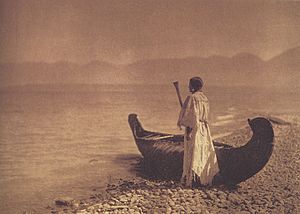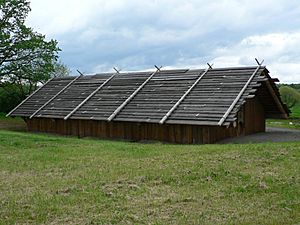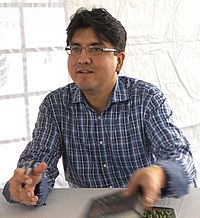Indigenous peoples of the Northwest Plateau facts for kids
The Indigenous peoples of the Northwest Plateau are Native American groups who have lived for thousands of years in the inland areas of what is now British Columbia, Canada, and the Pacific Northwest states of the United States. They are also known as the Plateau Indians.
Their homes are mainly in the river basins of the Columbia and Fraser Rivers. This includes parts of central and southern British Columbia, northern Idaho, western Montana, eastern Washington, eastern Oregon, and northeastern California. The eastern side of the Cascade Range mountains is also part of their traditional lands.
These groups have some special ways of life that make them different from other Native cultures nearby. They relied a lot on roots like biscuitroot and camas for food. They also depended on short seasons of salmon and eel fishing. They lived in fixed winter villages near rivers or lakes for a long time each year. Unlike some other groups, they did not have strict social classes or large tribal organizations beyond their villages.
Contents
Where They Lived

In Canada, most of the Interior Plateau was home to Interior Salish peoples. These include the Lillooet tribe in the Lillooet River Valley and the Thompson First Nations in the Fraser River Valley. The Secwepemc (Shuswap) lived along the Fraser River and in the Thompson River basin. The Okanagan people lived in the Okanagan River Valley, and the Lakes people lived near the Arrow Lakes.
The Kutenai tribe, who speak a unique language, live in southeastern British Columbia and used to live in southwestern Alberta. Athapaskan-speaking people, like the Chilcotin and Carrier, lived in the northernmost part of the Plateau region.
The Plateau First Nations traded many goods with the First Nations of the Pacific Coast. The Pacific tribes had beliefs about clan ancestors, which some Interior Salish groups adopted. However, they did not adopt the Pacific Coast's social system.
In the United States, Interior Salish people lived along the Columbia River and its smaller rivers. Sahaptin people lived along the Columbia River further south and up the Snake River. The Nez Perce lived in the Clearwater and Salmon River basins and along the Snake River through Hells Canyon. The Cayuse lived in the Blue Mountains. The Molala lived on the eastern side of the Cascade Mountains in Oregon. The Klamath people lived in the upper Klamath River basin. Their way of life was more like the Plateau culture, even though they were close to people from the California cultural area.
The Chinook people lived along the Columbia River below Celilo Falls. Some Chinook people near the mouth of the Columbia are considered part of the Northwest Coast culture. Sahaptin groups also lived in western Washington. The Willamette Valley was home to the Kalapuya people. Their culture was a bit different because they didn't have a major salmon run. They kept oak savannas similar to many California natives.
A Look at Their History
Plateau people did not keep written records. However, we can learn about their past from oral traditions (stories passed down), language studies, and archeological finds. Archeologists have found signs of humans living on the Plateau for at least 12,000 years. Places like the Marmes Rockshelter show early human presence.
Over time, people learned to use tools and methods that fit their unique environment. For example, earth ovens used for cooking camassia bulbs have been found that are up to 8,000 years old. About 4,000 years ago, archeological evidence shows a change from small groups to larger, more settled villages. People also started using more tools for processing roots, which are key parts of Plateau culture.
Language studies and oral traditions suggest that some groups moved into the Plateau more recently. For instance, Interior Salish peoples likely expanded from the lower Fraser River area. This movement reached as far as Montana about 1,500 years ago. Also, Athabaskan-speaking groups on the Plateau came from northern Canada and Alaska as recently as 1,000 years ago. The Kalapuya people spread into the Willamette Valley in the last 1,000 years.
Around 1730, horses were brought to the Plateau from the Great Basin. The Cayuse and Nez Perce were among the first to use them. Horses greatly changed how these groups lived and how far they could travel. This change was still happening when Europeans arrived. The Kutenai people's oral traditions say they came from the east and moved onto the Plateau in ancient times.
First Contact with Europeans
Life on the Plateau began to change even before Europeans arrived directly. A smallpox epidemic in the 1770s spread across the region, greatly reducing the population. The Lewis and Clark Expedition were the first Europeans to meet Plateau natives. A few years later, Alexander Ross and David Thompson also explored the area. All of them wrote about the people's clothing, food, and generally peaceful nature.
In the following decades, several trading posts were set up, such as Fort Nez Percés, Fort Colville, Fort Okanogan, and Fort Kamloops. More epidemics hit the area, with the Lower Columbia region suffering the most. Some Chinook and Kalapuya groups lost 90% of their population during this time.
While there was some minor fighting, serious armed conflicts did not start until many European Americans began moving to the southern Plateau in the 1840s. Through a series of treaties and wars, including the Cayuse War, Yakima War, Coeur d'Alene War, Modoc War, and Nez Perce War, native peoples in the southern Plateau were moved to reservations. This greatly disrupted their traditional way of life.
Tribes and Bands
Plateau peoples often identified themselves by their winter village or small group, rather than a large tribe. Marrying between different groups was common and often encouraged. Different groups shared hunting and gathering areas. After Europeans arrived, natives were grouped into "tribes" led by "chiefs." This was done to make it easier for Europeans to negotiate and settle land agreements.
Some commonly recognized Plateau tribes include:
- Chinook peoples
- Interior Salish
- Chelan
- Coeur d'Alene Tribe, ID, MT, WA
- Flathead (Selisch or Salish), ID and MT
- Bitterroot Salish
- Kalispel (Pend d'Oreilles), WA and MT
- Lower Kalispel, WA
- Upper Kalispel, MT
- In-SHUCK-ch, BC (Lower Lillooet)
- Lil'wat, BC (Lower Lillooet)
- Methow, WA
- Nespelem, WA
- Nlaka'pamux (Thompson people), BC
- Nicola people (Thompson-Okanagan confederacy)
- Okanagan, BC and WA
- Sanpoil, WA
- Secwepemc, BC (Shuswap people)
- Sinixt (Lakes), BC, ID, and WA
- Sinkayuse
- Sinkiuse-Columbia, WA (extinct)
- Spokane people, WA
- St'at'imc, BC (Upper Lillooet)
- Wenatchi (Wenatchee)
- Sahaptin people
- Upper Cowlitz or Taidnapam
- Kittitas (Upper Yakima)
- Klickitat Tribe, WA
- Lower Snake people: Chamnapam, Wauyukma, Naxiyampam
- Nez Perce, ID
- Palus (Palouse), ID, OR, and WA
- Pshwanwapam (Pswanwapam)
- Skinpah (Skin)
- Tenino (Warmsprings)
- Tygh (Upper Deschutes), OR
- Umatilla, OR
- Walla Walla, WA
- Wanapum, WA
- Wauyukma
- Wyam (Lower Deschutes)
- Yakama, WA
- Other or multiple
- Cayuse, OR
- Celilo (Wayampam)
- Cowlitz, WA
- Klamath, OR
- Modoc
- Kalapuya, northwest OR
- Atfalati (Tualatin, northwest OR)
- Mohawk River, northwest OR
- Santiam, northwest OR
- Yaquina, northwest OR
- Kutenai (Kootenai, Ktunaxa), BC, ID, and MT
- Modoc, CA and OR
- Molala (Molale), OR
- Nicola Athapaskans (extinct), BC
- Upper Nisqually (Mishalpan)
Languages They Spoke
Plateau tribes mainly spoke Interior Salish languages in the north and Plateau Penutian languages in the south. Chinookan languages were spoken on the lower Columbia River. Kalapuyan languages were spoken in the Willamette Valley. These are often grouped under Penutian languages, but not everyone agrees on this. In the northernmost Plateau, Athabaskan languages were spoken. Each of these language families had many different languages that people could not understand each other easily. Many individual languages also had different dialects.
The Ktunaxa people speak the Kutenai language, which is a language isolate. This means it is not clearly related to any other known language. The Cayuse language disappeared shortly after Europeans arrived and is not well documented. It is sometimes called an isolate, or sometimes linked to the Molala language. Even before being moved to reservations, many Cayuse people had started speaking the Nez Perce language.
Daily Life and Culture

Food They Ate
Traditional Plateau food included wild plants, fish (especially salmon), and game animals. Plateau peoples often moved to different seasonal villages or camps to find the best wild foods. Women gathered many types of edible vegetables and fruits. These included camassia, bitterroot, kouse root, serviceberry, chokecherry, huckleberry, and wild strawberry.
Camas lily bulbs were a very important food, but they could be dangerous. Common camas has blue flowers and its bulbs are safe to eat. However, the white-flowering death camas is a different plant that is deadly poisonous. To stay safe, Plateau peoples gathered these bulbs when the plants were still growing. This way, they could correctly identify the edible species. They dug the bulbs using deer antlers. Women cooked the roots in a shallow pit filled with hot stones. Once the ground was hot, the stones were removed, and the bulbs were placed in the hole to cook overnight.
Plateau women also made berry cakes using Saskatoon berries or huckleberries. They dried the berries on racks covered with leaves. Most Plateau groups also gathered a black moss called Wila. This moss was cooked in pits, sometimes along with camas. Gathering and preparing wild plants is still a traditional way of life for many people from these tribes today.
Men added to the diet by hunting and fishing. Salmon was a huge part of their food supply. When horses were introduced, the Plateau people's world grew. They could trade with tribes on the plains east of the Rocky Mountains for bison meat and hides. Groups of hunters rode far to hunt bison, deer, and elk.
In the spring and fall, salmon would swim up the rivers from the Pacific Ocean. Plateau fishermen knew many ways to catch salmon. They used Dipnets, gaffs, or gigs, depending on the fishing spot. On main rivers, seine nets were used where salmon or eels gathered. They would also set up stakes to make a weir, which stopped the salmon. Then, they would scoop the fish out of the water. Suckers were caught in fish traps as they swam down smaller streams. Most salmon was smoked over a fire, and some was stored underground. Other salmon was boiled to get oil.
Birds were often caught with nets. Men used several methods to hunt large animals. Groups of men would surround and drive deer or elk towards other hunters or into traps. They also used Trapping pits and snares. How much they relied on big game depended on how much salmon was available. Hunting provided less than ten percent of the food for some Chinook and Sahaptin groups on the Columbia River. Further upstream, hunting was more important.
Tools and Crafts
Plateau tribes were very skilled at making baskets. They often used hemp dogbane, tule, sagebrush, or willow bark. These materials were also used to make hats, bedding, nets, and ropes. Basketry was especially important because Plateau tribes did not use pottery. They boiled water in baskets by putting heated stones into them. The ancestors of the Plateau Indians made the oldest known shoes in the world, the Fort Rock sandals. These sandals were made of twined sagebrush and are about 10,000 years old.
Tools were made from wood, stone, and bone. Arrows for hunting were made from wood with arrowheads chipped from special rocks. Animal antlers were used for digging roots. Later, they also started using metal items like pots, needles, and guns, which they got from trading with Europeans.
Homes and Shelters
Plateau homes included longhouses with roofs made of summer tule mats. Tule is a tall, tough reed that grows in marshy areas. For winter homes, people dug a pit a few feet into the ground. They built a framework of poles over it, meeting at a peak. They covered this with tule mats or tree bark. Earth was piled around and partly over the structure to keep the semi-underground shelter warm. These large winter lodges were shared by several families. They were rectangular at the bottom and triangular at the top. They had several layers of tule. As the top layers absorbed moisture, they swelled, stopping water from reaching the lower layers and the inside of the lodge.
In later years, people used canvas instead of tule mats. Starting in the 1700s, Plateau peoples began using tipis, which they learned about from the Plains Indians. Tipis were made of a pole framework covered with animal skins or woven mats. Each month, women would stay temporarily in round menstrual huts, about 20 feet (6 meters) across.
Interior Salish winter homes were special. They were semi-underground pit-houses with very well-insulated roofs. Logs were carved into steps at the entrances. Dried food was stored outside these winter houses. In the summer, the Salishan people lived in tule mat houses. Other tribes made their homes from pieces of cedar or spruce bark. Cedar homes had slanted roofs that reached almost to the ground, while spruce-bark houses looked like adjacent tents.
What They Wore
Plateau people wore different types of clothing that changed over time. In the northern region, women wore buckskin shirts, breech cloths, leggings, and moccasins. Men wore longer shirts. Winter clothing was made from rabbit, groundhog, or other animal furs. Along the Columbia River, among the Chinook and Sahaptin, both men and women usually wore just a breech cloth in warm weather. A short robe or cape and leggings were added when it was cooler. Below the Cascades Rapids, women wore grass skirts. Women on the southern Plateau wore basketry hats. Over time, Plateau people generally adopted clothes inspired by Plains culture, including buckskin dresses and feathered headgear.
Arts and Traditions
Today, Native peoples still make traditional clothing, bags, baskets, and other items. Even though some knowledge of traditional arts has been lost as times change, practicing these fine skills is still an important part of their way of life. Mothers and grandmothers decorate their children's outfits for celebrations and dancing. Beaded items, such as drums, woven bags, and other crafts, are used in traditional celebrations and special occasions. Such special clothing is used for days during the Spirit Dance, which happens once a year.





